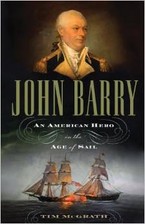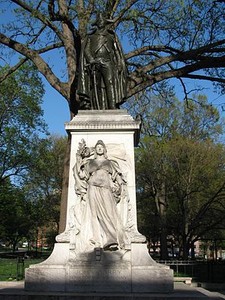John Barry Memorial, Franklin Square Washington DC
Introduction
Text-to-speech Audio
Images
Direct View of Boyle Statue

John Barry: An American Hero in the Age of Sail-Click the link below for more information about this book

1830 painting depicting Washington giving Barry his commission as Commodore

Closer look at the John Barry Memorial

Backstory and Context
Text-to-speech Audio
John Barry was born in a thatched cottage in 1745 in County Wexford, Ireland. This southeastern section of Ireland has always had a strong maritime tradition. Barry’s father was a poor tenant farmer who was evicted by his British landlord and the family moved to Rosslare. It was there that Barry followed his uncle to sea, starting out as a ship’s cabin boy, and gradually becoming an experienced well-respected seaman.
Barry moved to the United States where his first command came in 1776 on the schooner Barbados, out of Philadelphia, which Barry adopted as his home port. By sailing back and forth between Philadelphia and the West Indies, Barry acquired command skills at the helm of several merchant ships. He made at least nine round trips without a mishap and Philadelphians called him “Big John” due to his reliability, personable nature and his success in the merchant shipping business. IN 1772, Barry’s skills came to the attention of Philadelphia’s largest merchant shipping firm Willing, Morris and Cadwalader, and Robert Morris himself, a Revolutionary financier. Barry was assigned to captain the Black Prince, their 200 ton ship in which he ultimate made a record of traveling 237 miles over a 24-hour period – the fastest sailing recorded in the 18th century.
When Barry arrived back in Philadelphia he learned that the colonies and Great Britain were at war. Barry was given the task of outfitting the first Continental Navy ships which were put to sea from Philadelphia. His assignment included overseeing rigging, piercing gunports, strengthening bulwarks, procuring power and canvas for the new warships and loading provisions. Upon completion of his work, the Continental Congress Marine Committee gave him a Captain’s commission in the Continental Navy dated March 14, 1176, signed by the President of the Congress, John Hancock. Along with his commission was the command of the warship brig Lexington.
In his first contest at sea, the Lexington had a successful one-hour battle with a British tender. Then late in 1776 Barry was given command of the 32-gun Effingham, then under construction in Philadelphia. While it was under construction, Barry volunteered his service to the Continental Army.
He served as an aide-de-camp with a company of Marines under the command of Philadelphia militia commander General John Cadwalader, a part owner of the merchant shipping company Barry worked with before the way. General Washington chose Barry as his courier in conveying wounded prisoners through British lines and carrying a dispatch under a flag of truce to General Cornwallis.
In March 1778 Barry went back to sea and attacked a British fleet with a tiny squadron of tubs. He succeeded in destroying three ships, holding off a frigate and a ship-of-the-line and garnering vital British intelligence and valuable Engineer’s entrenching tools. Washington sent Barry a letter commending him on his bravery. He was assigned to the 32-gun frigate, Raleigh, which was cornered in a Maine cove by the British. Barry refused to surrender and was able to save his crew.
In 1781 Barry was commanding the 36-gun frigate Alliance when it took on two British ships, the sloops Atlanta and Trespassy off the coast of Newfoundland. The two smaller ships were able to use sweeps and maneuver close to the prow and stern of the Alliance. Wounded, Barry returned to the deck to continue the fight. The British sloops had managed to severely damage the Alliance. Unwilling to surrender his colors, Barry determined to fight on. Suddenly, a gust of wind caused the battered Alliance to swing about. Its whole starboard battery was employed bringing 12 12-pound cannons into the right. After two successful broadsides, the two sloops struck their colors and surrendered.
Barry’s final battle of the Revolution was also the last sea battle of the Continental Navy. On March 10, 1783, Barry was returning from Havana aboard the Alliance with a shipment of 72,000 Spanish silver dollars for the Continental Congress. Off the coast of Cape Canaveral, Florida, the Alliance engaged in a battle with the British frigate Sybil. A 45 minute exchange of gunfire ensured. Barry directed his gun crews with superb results. The British vessel sheared off after receiving severe punishment from the American crew who shattered her rigging.
After the war was over, Barry resumed the maritime trade and opened commerce with China and the Orient. On February 22, 1797, President George Washington called Barry to his mansion at 190 High (Market)Street to receive Commission Number One in the Navy dated June 4, 1794. Barry held the courtesy title of Commodore from that period. His contributions to the navy were significant. He authored a Signal Book in 1780 which established a set of signals to be used for effective communications between ships voyaging in squadron formation. Barry also suggested the creation of a Department of the Navy with a separate cabinet status from the Secretary of War. This was finally realized in 1798. Barry’s suggestions about establishing a government-operated navy yards were also realized. So many of the heroes of the War of 1812 were trained under Barry’s tutelage that he earned the nickname “Father of the Navy.”
